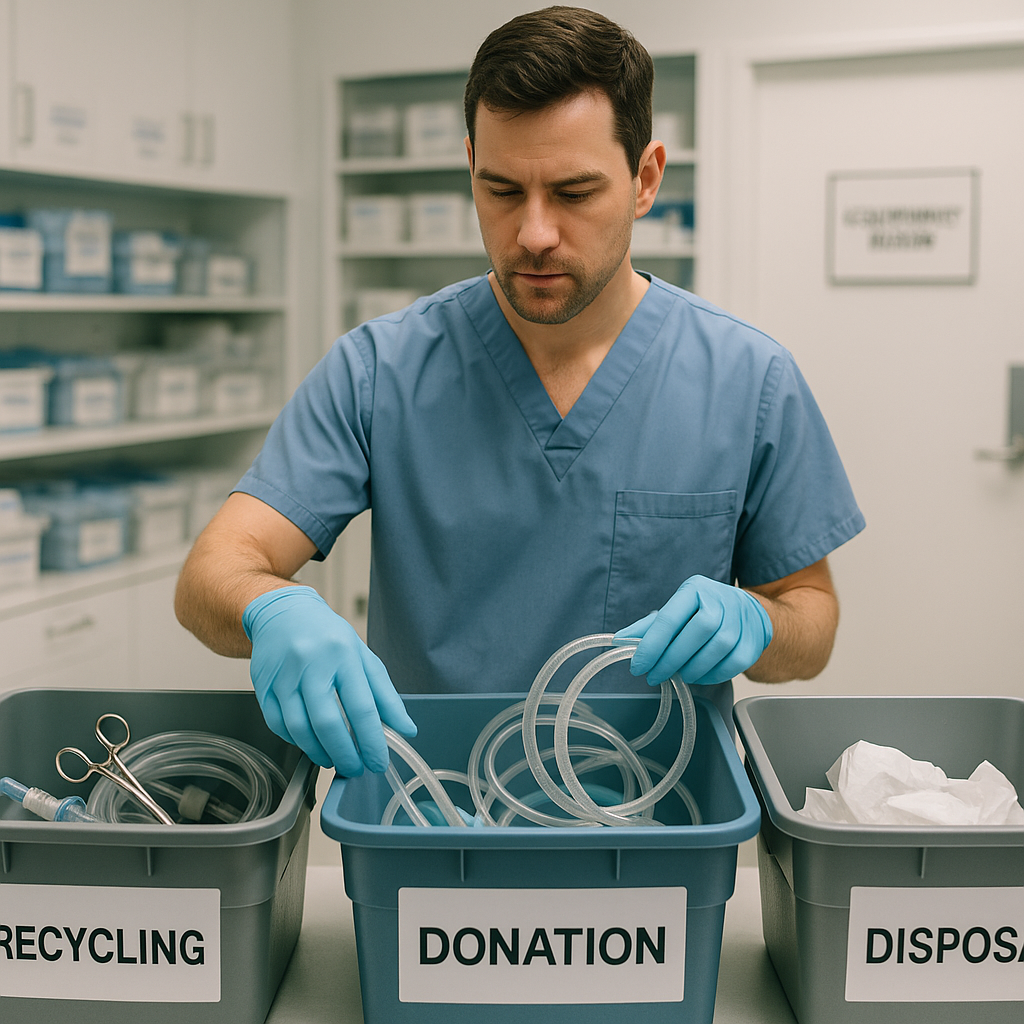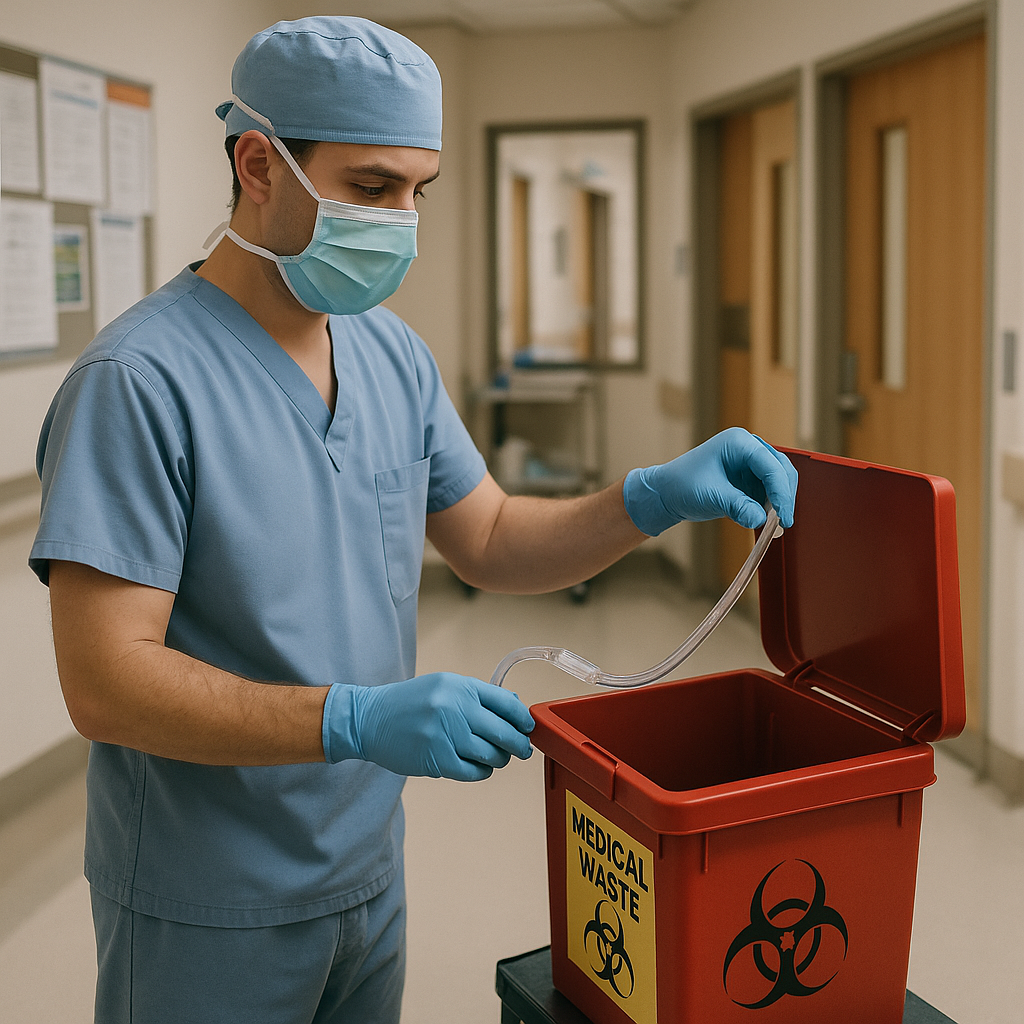5901 Botham Jean Blvd, Dallas, TX 75215
Commercial Equipment Recycling: Benefits, Processes, and Sustainable Business Practices
September 5, 2025Medical equipment disposal refers to the process of safely discarding or recycling used medical devices and supplies that are no longer needed in healthcare settings. This critical procedure applies to everything from large machines like MRI scanners and CT equipment to smaller devices such as glucose monitors and surgical instruments.
Proper disposal matters for several important reasons. Medical equipment often contains sensitive patient data, potentially hazardous materials, or components that can harm the environment if sent to landfills. The safe removal and handling of these items prevents contamination of soil and water sources while protecting public health from potential exposure to harmful substances.
Healthcare facilities generate vast amounts of equipment waste annually, with only about 15% being truly hazardous despite up to 90% being incinerated. This creates both a challenge and an opportunity for implementing more sustainable disposal practices. With proper management, much of this equipment can be refurbished, repurposed, recycled, or safely decommissioned rather than contributing to environmental problems.
What Are the Options for Disposing of Medical Equipment?

The disposal of medical equipment requires careful consideration. The environmental impact of improperly discarded medical devices can be significant, with electronic components potentially leaching harmful substances into soil and groundwater. Fortunately, there are several responsible options for handling unwanted or outdated medical equipment.
Donation to Healthcare Facilities
When medical equipment remains in good working condition, donation offers an excellent opportunity to extend its useful life while helping organizations in need. Many hospitals, clinics, and healthcare providers accept gently used equipment to supplement their resources.
Organizations like MedShare recover millions of pounds of surplus medical supplies annually that would otherwise end up in landfills. Items particularly suitable for donation include:
- Hospital beds and exam tables
- Wheelchairs and mobility aids
- Imaging equipment like ultrasound and X-ray machines
- Laboratory equipment
- Respiration monitors and defibrillators
Before donation, equipment should be properly sanitized and sterilized to ensure safety for future users. This process may involve autoclaving, chemical disinfection, or ultraviolet radiation treatment.
Manufacturer Take-Back Programs
For malfunctioning equipment, many manufacturers offer take-back programs where they accept their products for refurbishment or proper disposal. These programs sometimes provide credit toward new equipment purchases, creating a financial incentive for healthcare facilities.
Equipment commonly eligible for manufacturer take-back includes:
- MRI and CT scanners
- Advanced diagnostic equipment
- Electronic monitoring devices
- Surgical instruments
- Specialized medical technology
Contact the original manufacturer to determine if they have an established program for the specific equipment you need to dispose of.
Medical Equipment Recycling
When equipment is no longer functional, certified medical waste recyclers can properly disassemble and recycle the components. These specialists understand how to handle potentially hazardous materials safely while recovering valuable resources.
For smaller devices like glucose monitors or defibrillators that are no longer working, recycling is relatively straightforward but still requires specialized handling. Due to the technical nature of medical devices and how they’re used, standard recycling bins are not appropriate.
Items commonly processed by medical equipment recyclers include:
- Electronic medical devices
- Metal surgical instruments
- Physical therapy equipment
- Endoscopy equipment
- Medical-grade plastics
State and Local Recycling Programs
Many regions have established specific programs for medical equipment recycling and reuse. For example, Maryland’s Durable Medical Equipment Re-Use program accepts donations at various collection centers throughout the state, helping divert usable equipment from landfills while providing it to those in need.
Equipment collected through these programs typically includes:
- Canes, crutches, and walkers
- Shower chairs and tub transfer benches
- Manual and power wheelchairs
- Hospital beds
- Mechanical lifts
Check with your local waste management authority or department of aging to identify similar programs in your area.
What Regulations Govern Medical Equipment Disposal?

Medical equipment disposal exists within a complex regulatory framework primarily governed at the state level. Each state’s environmental protection agency and health department establishes specific guidelines that healthcare facilities must follow when disposing of medical equipment. These regulations can vary significantly from state to state, making compliance a location-specific challenge for healthcare providers.
While states take the lead in regulating medical waste, several federal agencies also maintain oversight roles. The Environmental Protection Agency (EPA) previously established the Medical Waste Tracking Act, which expired in 1991 but created a foundation for many current state regulations. Today, the EPA continues to regulate medical waste incinerator emissions under the Clean Air Act to reduce potential health hazards.
The Occupational Safety and Health Administration (OSHA) focuses on protecting healthcare workers through regulations covering sharps management, container requirements, waste labeling, and employee training. These standards address the occupational hazards associated with medical waste handling, particularly the risk of bloodborne pathogen exposure.
Additional federal oversight comes from the Centers for Disease Control and Prevention (CDC), which provides guidelines for infection control practices, and the Food and Drug Administration (FDA), which offers guidance on specific medical device disposal.
Most state regulations address several key aspects of medical waste management:
- Waste segregation and categorization
- Packaging, labeling and storage requirements
- Transportation protocols
- Treatment and disposal methods
- Documentation and tracking procedures
- Staff training requirements
Healthcare facilities must properly classify medical equipment waste based on categories that typically include sharps, pathological waste, microbiological waste, and bulk human fluids. Each category has specific handling protocols to minimize infection risk.
Many states require healthcare facilities to work with certified medical waste disposal companies that specialize in compliant handling and treatment of regulated waste. These companies must obtain permits and follow strict protocols for waste transportation, treatment, and final disposal.
Compliance failures can result in significant penalties, including fines, facility shutdowns, and legal liability. Healthcare organizations should develop comprehensive waste management plans that address both state and federal requirements while designating responsible personnel for ensuring ongoing compliance.
The treatment of medical waste before disposal is another heavily regulated area. Common treatment methods include autoclaving (steam sterilization), chemical disinfection, microwave treatment, and incineration—each with its own regulatory requirements and environmental considerations.
Given the variation in state regulations, healthcare facilities should regularly review their state-specific requirements through resources like the Healthcare Environmental Resource Center, which provides state-by-state guidance on medical waste regulations.
Proper medical equipment disposal also intersects with other regulatory areas, including patient privacy (for equipment containing protected health information), environmental protection, and occupational safety. This regulatory complexity underscores the importance of developing a comprehensive compliance strategy rather than addressing each regulation in isolation.
What Are Best Practices for Safe Medical Equipment Disposal?

Medical equipment disposal requires careful attention to protect both human health and the environment. Healthcare facilities generate various types of medical waste that need specific handling procedures to prevent contamination and ensure regulatory compliance.
Proper Waste Segregation
Segregate waste at the source to ensure each type is handled correctly. This critical first step prevents contamination and reduces the amount of waste requiring specialized treatment. Healthcare facilities should separate infectious waste, sharps, pharmaceutical waste, and other hazardous materials immediately after use.
Different waste categories require specific handling methods. Non-infectious items like IV bags without blood and non-bloody gloves can be discarded with regular solid waste, while infectious materials need special treatment.
Appropriate Containment Solutions
Using the right containers for different waste types is essential for safe handling and disposal. Sharps must be disposed of in puncture-resistant containers immediately after use to prevent needlestick injuries. These rigid containers should be clearly labeled as biohazardous waste.
For other infectious medical waste, use leak-proof, sturdy biohazard bags that can withstand handling without breaking. If the exterior of a bag becomes contaminated, place it inside a second biohazard bag. All bags should be securely closed before disposal.
Treatment Before Disposal
Infectious medical waste requires treatment to render it non-infectious before final disposal. Common treatment methods include:
- Steam sterilization (autoclaving) at appropriate temperatures and times
- Chemical disinfection using approved agents
- Microwave or other thermal treatment systems
- On-site treatment technologies for specific waste streams
Sterilize contaminated equipment using methods appropriate for the specific waste type. This step is particularly important for cultures and stocks of infectious agents from laboratory settings.
Secure Storage Practices
Proper storage before pickup prevents access by unauthorized individuals and protects from environmental factors. Store medical waste in labeled, leak-proof, puncture-resistant containers in well-ventilated areas inaccessible to pests. The storage area should minimize odors and prevent exposure risks.
Regular disposal schedules help avoid unnecessary accumulation of medical waste. Never store medical waste near food preparation or patient care areas.
Electronic Medical Device Disposal
Electronic medical equipment presents unique challenges due to both data security and potential environmental hazards. Remove all patient data from electronic devices before disposal. This includes clearing hard drives, memory cards, and any other storage components to prevent privacy breaches.
Many electronic devices contain hazardous components that require special handling. Work with vendors that comply with e-waste regulations and can provide certificates of destruction for data-containing devices.
Documentation and Tracking
Maintaining proper records is essential for regulatory compliance and risk management. Use a chain of custody documentation to track waste from generation to final disposal. Keep these records according to regulatory requirements, typically for at least three years.
Request documentation from your medical waste disposal company confirming proper management and final disposition of the waste. This creates an audit trail that demonstrates regulatory compliance.
Transportation Considerations
Always use licensed medical waste transporters with knowledge in handling infectious waste. These specialists understand regulatory requirements and have equipment designed to contain all waste and prevent environmental releases.
Vehicles transporting medical waste should meet Department of Transportation requirements, and drivers should be trained in spill containment and cleanup procedures.
Staff handling medical waste should receive appropriate training on waste identification, segregation, handling procedures, and spill management. Regular updates to this training help maintain compliance with evolving regulations.
Following these best practices not only ensures regulatory compliance but also protects public health and the environment from potential hazards associated with improperly managed medical waste.
Conclusion
Medical equipment disposal is more than just a logistical task—it is a matter of protecting public health, safeguarding the environment, and ensuring compliance with complex state and federal regulations. By following best practices, such as segregation, sterilization, recycling, and secure storage, healthcare facilities can reduce risks, extend the useful life of equipment, and contribute to more sustainable medical waste management. Whether donating functional devices, participating in manufacturer take-back programs, or working with certified recyclers, healthcare providers have multiple pathways to responsibly manage end-of-life medical equipment.
Partner with Okon Recycling for safe, compliant, and environmentally responsible disposal of medical equipment. Call us today at 214-717-4083 to schedule your medical equipment recycling or disposal service.
